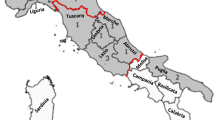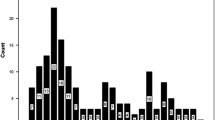Abstract
Background and aims: To define differences in rehabilitative outcome after Spinal Cord Injury (SCI), according to age at injury. Methods: This is a prospective, observational, follow-up study. Completion of a questionnaire administered by a psychologist through a telephone interview to subjects discharged about 4 years previously from 22 SCI centers in Italy, who had already participated in a prospective multicenter study. A total of 403 out of 511 patients with SCI (79%), discharged between 1997 and 1999 after comprehensive rehabilitation in SCI centers, who gave their consent to a telephone interview. Main outcome measures are: number of re-admissions and medical consultations for clinical problems during follow-up (FU) period, clinical outcome related to bowel/ bladder function, family, sentimental and personal satisfaction, mobility, three-day autonomy, subjective feelings of dependency, subjective perception of quality of life. Results: The sample population was categorized into two subgroups according to severity on the Asia Spinal Injury Association (ASIA) scale by the ROC method: 276 subjects, the younger group were aged between 0 and 49 years, mean age 32 (±8 yrs), and 127 subjects in over 50 group, mean age 63 (±8 yrs). Differences in sample characteristics were found as regards cervical/dorsal lesion distribution and incompleteness of damage, more frequent in the older group. Incidence of hospital re-admissions and medical consultations, bladder autonomy, bowel autonomy and bowel continence were similar in both groups. Variables related to personal and social life, as well as life satisfaction, showed significant differences, with worse outcomes in the older group. Conclusions: Age at injury deserves major attention, as persons not yet in geriatric age may show greater vulnerability after SCI.
Similar content being viewed by others
References
Go BK, De Vivo MJ, Richards JS. The epidemiology of SCI. In Stover SL, De Lisa JL, Whiteneck GG, Eds. Spinal Cord Injury: Clinical Outcome from the Model System. Baltimore: Aspen, 1995: 21–54.
Pagliacci MC, Celani MG, Zampolini M et al. An Italian survey of traumatic Spinal Cord Injury: the Gruppo Italiano Studio Epidemiologico Mielolesioni study. Arch Phys Med Rehabil 2003; 84: 1266–75.
Shingu H, Ikata T, Katoh S, Akatsu T. Spinal cord injuries in Japan: a nationwide epidemiological survey in 1990. Paraplegia 1994; 32: 3–8.
Watson N. Pattern of spinal cord injury in the elderly. Paraplegia 1976; 14: 36–40.
De Vivo M, Stover SL, Black KJ. Prognostic factors for 12- year survival after spinal cord injury. Arch Phys Med Rehabil 1992; 73: 156–62.
Kannus P, Niemi S, Palvanen N, Parkkari J. Continuously increasing number and incidence of fall-induced, fracture-associated, spinal cord injuries in elderly persons. Arch Intern Med 2000; 160: 2145–9.
Kannus P, Palvanen N, Niemi S, Parkkari J. Alarming rise in the number and incidence of fall-induced cervical spine injuries among older adults. J Gerontol A Biol Sci 2007; 62: 180–3.
DeVivo MJ, Krause JS, Lammertse DP. Recent trends in mortality and causes of death among persons with spinal cord injury. Arch Phys Med Rehabil 1999; 80: 1411–9.
Anderson K, Aito S, Atkins M et al. Functional recovery measures for spinal cord injury: an evidence-based review for clinical practice and research. J Spinal Cord Med 2008; 31: 133–44.
Ditunno JF Jr, Ditunno PL, Graziani V et al. Walking index for spinal cord injury (WISCI): an international multicenter validity and reliability study. Spinal Cord 2000; 38: 234–43.
McColl MA, Charlifue S, Glass C, Lawson N, Savic G. Aging, gender, and spinal cord injury. Arch Phys Med Rehabil 2004; 85: 363–7.
Yarkony GM, Roth EJ, Heinemann AW, Lovell LL. Spinal cord injury rehabilitation outcome: the impact of age. J Clin Epidemiol 1988; 41: 173–7.
Liang HW, Wang YH, Lin YN, Wang JD, Jang Y. Impact of age on the injury pattern and survival of people with cervical cord injuries. Spinal Cord 2001; 39: 375–80.
DeJong G, Branch LG, Corcoran PJ. Independent living outcomes in spinal cord injury: multivariate analyses. Arch Phys Med Rehabil 1984; 65: 66–73.
Alander DH, Andreyehik DA, Stauffer ES. Early outcome in cervical spinal cord injured patients older than 50 years of age. Spine 1994; 19: 2299–301.
DeVivo MJ, Kartus PL, Rutt RD, Fine PR. The influence of age at time of spinal cord injury on rehabilitation outcome. Arch Neurol 1990; 47: 687–91.
Franceschini M, Di Clemente B, Citterio A, Pagliacci MC. Followup in persons with traumatic spinal cord injury: questionnaire reliability. Eura Medicophys 2006; 42: 211–8.
Pagliacci MC, Franceschini M, Di Clemente B, Agosti M, Spizzichino L. A multicentre follow-up of clinical aspects of traumatic spinal cord injury. Spinal Cord 2007; 45: 404–10.
Kennedy P, Evans MJ, Berry C, Mullin J. Comparative analysis of goal achievement during rehabilitation for older and younger adults with spinal cord injury. Spinal Cord 2003; 41: 44–52.
Chafetz RS, Vogel LC, Betz RR, Gaughan JP, Mulcahey M. International standards for neurological classification of spinal cord injury: training effect on accurate classification. J Spinal Cord Med 2008; 31: 538–42.
Roth EJ, Lovell L, Heinemann AW, Lee MY, Yarkony GM. The older adult with a spinal cord injury. Paraplegia 1992; 30: 520–6.
Penrod LE, Hedge SK, Ditunno JF. Age effect on prognosis for functional recovery in acute, traumatic central cord syndrome. Arch Phys Med Rehabil 1990; 71: 963–8.
Scivoletto G, Morganti B, Ditunno P, Ditunno JF, Molinari M. Effect of age on spinal cord lesion patients’ rehabilitation. Spinal Cord 2003; 41: 457–64.
Dai LY. Acute central cervical cord injury: the effect of age upon prognosis. Injury 2001; 32: 195–9.
Cifu DX, Seel RT, Kreutzer JS, Mc Kinley WO. A multicenter investigation of age related differences in length of stay, hospitalization charges and outcomes for a matched tetraplegia sample. Arch Phys Med Rehabil 1999; 80: 733–40.
Nobunaga AI, Go BK, Karuna RB. Recent demographic and injury trends in people served by the Model Spinal Cord Injury Care Systems. Arch Phys Med Rhabil 1999; 80: 1372–82.
Stover SL, Fine PR. Spinal cord injury: the facts and figures. Birmingham, AL: The University of Alabama at Birmingham, 1986.
Strauss DJ. Trends in life expectancy after spinal cord injury. Arch Phys Med Rehabil 2006; 87: 1079–85.
Krause JS. Aging and life adjustment after spinal cord injury. Spinal Cord 1998; 36: 320–8.
Author information
Authors and Affiliations
Corresponding author
Rights and permissions
About this article
Cite this article
Franceschini, M., Bazo, H.C., Lauretani, F. et al. Age influences rehabilitative outcomes in patients with spinal cord injury (SCI). Aging Clin Exp Res 23, 202–208 (2011). https://doi.org/10.1007/BF03324961
Received:
Accepted:
Published:
Issue Date:
DOI: https://doi.org/10.1007/BF03324961




